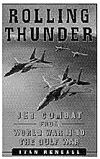 Rolling Thunder, by Ivan Rendall, The Free Press, 1999, 336 pp, $26.00
Rolling Thunder, by Ivan Rendall, The Free Press, 1999, 336 pp, $26.00
Ivan Rendall is a good writer, with an easy-to-read narrative style. He intersperses his history with personal accounts of participants, and he's a good interviewer. The basic thesis of the book is that if you're going to have an air force, the best air force is the only one worth having.
He illustrates that argument, an axiom of air warfare, with accounts from WW II, Korea, Vietnam, the Middle East, the Falklands, and Desert Storm. He also covers several interwar periods and the development of air warfare doctrine and technology during those times.
It's a fast read and a good one, and I learned a lot. He's an ex-RAF pilot and knows what he's talking about - most of the time. He makes several statements that are incorrect. For example he describes the Argentine carrier Vienticinco de Mayo as an ex-US vessel, when it was actually an ex-UK, ex-Netherlands ship. He says the Adnan AEW aircraft used by the Iraqis is of Soviet origin, when in reality it was developed locally by the Iraqis. He makes them sound like an effective platform, but there is also no indication that they were working during the war, and there were only two of them. There are other errors, and while they don't weaken his argument, they are distracting.
He makes his point convincingly, demonstrating time and again what happens what happens when a country has air superiority, and what happens when it doesn't, and showing that the only way to get that advantage is by having a first-class air arm.
He does not live up to his promise, though. This book is subtitled "Jet Combat from World War II to The Gulf War," and there are a lot of wars that he never mentions: The 1956 Suez conflict, the Indo-Pakistani wars of 1965 and 1971, and the Iran-Iraq War of the 1980s. There are many other smaller skirmishes he could discuss as well, but the first ones I mentioned are all significant events and I missed them. I'm not saying he stacked the deck to strengthen his argument, but these smaller wars don't make his case as well as the larger ones.
But we can learn a lot from them. The Indians and Pakistanis both had good air forces, not in the same class as the UK's or America's or Israel's, but well-run. How did they do against each other? Is it just enough to have the "best" air force, or is their some minimum level required before it does you any good at all?
This is even more pertinent with the Iran-Iraq war, where air power was used and misused by two second-rate, possibly third-rate countries.
What can we learn from watching their efforts?
His theme is an important topic these days, when the Western air forces are dominant and the USA is the first among equals. Airpower is now an integral part of foreign policy. But in the recent operations in Kosovo, some US capabilities were so advanced it was difficult for some of her allies to work with her. Just how good do we have to be?
BT
Back to The Naval Sitrep #17 Table of Contents
Back to Naval Sitrep List of Issues
Back to MagWeb Master Magazine List
© Copyright 1999 by Larry Bond and Clash of Arms.
This article appears in MagWeb (Magazine Web) on the Internet World Wide Web.
Other military history articles and gaming articles are available at http://www.magweb.com